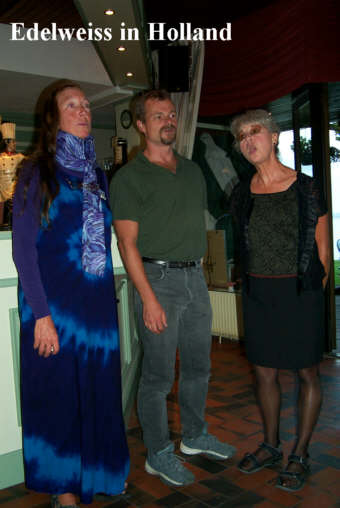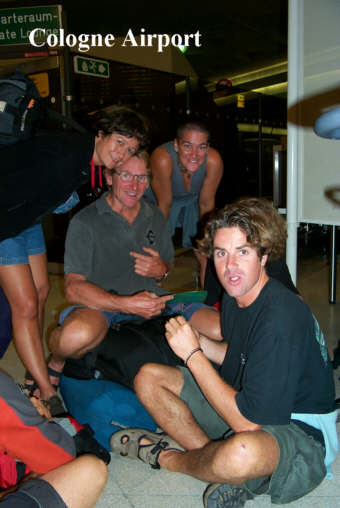

Page 90
Vietnam ![]()
Thailand ![]()
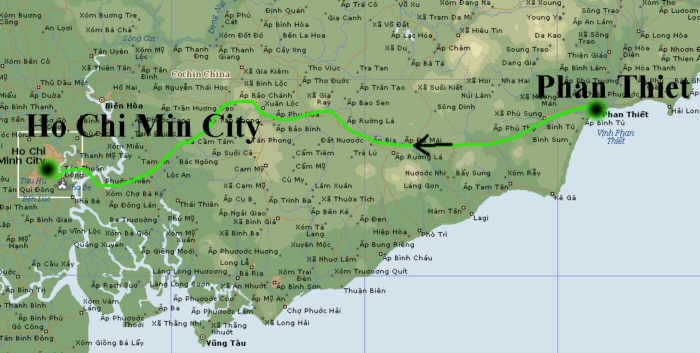
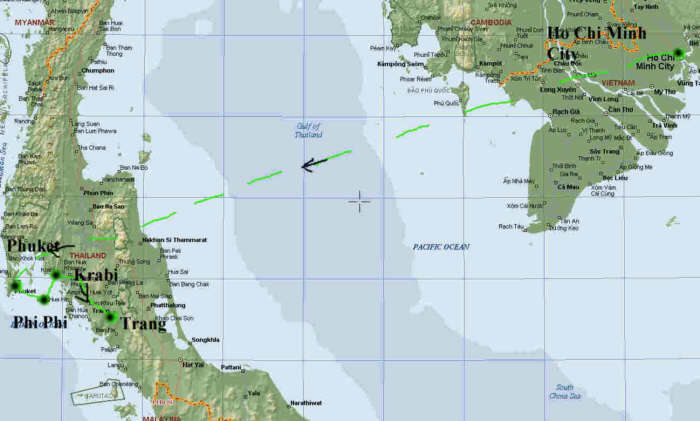
DAY
312
Phan Thiet to Ho Chi Minh City
November
7, 2000
This was our last day of cycling in Vietnam. It was to be another short day, ending at 113 km. with a bus ride the rest of the way. When I heard that I thought, ‘Thank goodness it is only 113 km.’ But superwoman Bobbi wailed, “I need to ride more than 113 km.!” She was in luck, there was a second bailout point closer to Ho Chi Minh City so that the gung-ho could ride 170 km., or if they needed, 200 km. before boarding a bus. The traffic any closer to Ho Chi Minh City was just too treacherous to risk. Some people, like Jim Higbee, set weekly mileage goals for themselves beyond what is the planned route. To get 200 km. a rider would have to ride to the 170 km. point where a bus waited, then backtrack 15 km., turn around and return to the bus. Trueheart did that but I haven’t heard which other riders did it. Some people are just nuts about cycling!
I was on a bus coming into Ho Chi Minh City when we overtook some of our cyclists who were riding to the 170 km. point including Spot, Ruth, and Trueheart. People on the bus were excited because it was the first time they’d ever seen True ride and he is amazing, beautiful to watch. Traffic was heavy, there were bumper to bumper busses and trucks, countless motorcycles, all spewing noxious black smoke, reducing visibility and making breathing hazardous to one’s health. Yet there was True, streaking through that mess, weaving in and out of the slower traffic. We cheered from inside our air-conditioned bus and he heard us, looked up and gave us one of his big grins. I think he was having a good time.
For a normal mortal riding in that traffic is rather a harrowing experience and I know that I am in the majority who appreciated that the rides in Vietnam have been short. It has been interesting to be on a bike and to see the countryside and the people from that vantage point, a view or a perspective that a tourist would not ordinarily have. We have done all of our miles on Highway 1 A, a new road in excellent condition with wide shoulders. This highway runs the length of Vietnam and is a lifeline, essential to the transport of goods and people. But riding on the highway is hard work because it is necessary to be constantly anticipating what everyone else may do. The normal rules for traffic do not apply here. The other drawback is the air pollution that at the very least makes it unpleasant to cycle.
Everything that can happen is happening on Highway 1 A. Perhaps the most amazing to me is that it is used as a giant food dehydrator. Any food that needs to be dried before storage is spread along the length of the highway. Maybe that is why the road was built with good wide shoulders! Highway 1 A is not a particularly clean highway. It has all the usual greasy spots from broken down trucks, and broken glass, etc. It also has animal dung because oxen and ponies are used to pull carts, and ducks, goats and cattle are herded down the highway, chickens search the shoulders for tasty tidbits, and dogs are free to roam anywhere they please. Garbage spills onto the highway in places, and at other times there may be the ashes from a fire. But never mind. It is a nice level spot completely open to the sun, and if it runs in front of one’s dooryard it is the perfect place to spread food to dry. Many foods are dried there: rice, coffee, corn on the cob, corn kernels, corncobs, spices and peppers, straw and hay and reeds and leaves for basket weaving, a plant resembling sugarcane that is first shredded, then spread in the sun, mushrooms or other types of fungi, potatoes and more. The people carry the food to be dried to the roadside in baskets or bags, dump it out and spread it using various methods including the feet and a rake. Once it is spread they go about their work elsewhere, leaving the food completely untended. We have seen bicycles pedal through rice and cattle leaving their droppings on it, and we even saw a dog urinating on coffee beans.
On this day I saw two cash crops I hadn’t seen yet in Vietnam, rubber trees and dragon fruit. Dragon fruit grows on a plant resembling a succulent. The fruit is as big as a grapefruit but more oblong than spherical with a red skin, which is not eaten. The dragon fruit is sliced into wedges for serving, unpeeled, and the red skin makes a vivid contrast with the stark white flesh, which contains countless tiny black seeds randomly dispersed. Something so strange and beautiful to look at should taste wonderful, but I at least, cannot taste any flavor whatsoever. But with dragon fruit and other fruit the Vietnamese serve a mixture guaranteed to liven up the blandest fruit. It consists of very finely chopped hot red peppers and salt. When I first saw it and tried it I thought it was colored sugar. Did I get a surprise!
Also in season now are pineapples, which we see displayed on roadside stands and which we are served at every dinner for dessert. They are delicious! We are also given green bananas that are sweet and ready to eat even though green, and little short, fat bananas which are also delicious.
Everything in Vietnam it seems is a wonderful bargain except the long distance telephone rates. They have varied from nearly $4 a minute to $7 a minute! Some riders are waiting to phone home or send Pocketmail until the rates are more reasonable. Perhaps that will be in Thailand.
I have finally made up my mind about whether to pay the $3,000 and finish the Odyssey. I have thought of arguments both ways, it wasn’t an easy decision, but I have chosen to pay and continue the trip that for me has been fine. Some people are quitting ‘on principle’ but even if their complaints are later proven to be well founded, it won’t change anything and they will have done themselves out of a good time. I overheard one of ‘them’ saying that anyone who would pay to go with TK&A is either too lazy or incompetent of planning their own trip for a month. How dare he! There are others like myself who are satisfied with the trip. It wasn’t perfect but has there ever been a trip without a glitch or two?
Goodbye,
Alice
DAY
313
Ho Chi Minh City Layover Day
November
8, 2000
So
much to see! So little time! One day in Ho Chi Minh City is not enough. The
tours offered included a city tour, a temple tour, a tunnel tour, and the Mekong
Delta. I chose the Mekong Delta because that phrase seemed full of mystery to me
and because I thought a bit of peace and quiet in the countryside would be
better than the chaos of the city. The tourist agency that has been contracted
by TK&A to provide busses and interpreters offered tours for $30. But we
found that a local agency with an office in our hotel offered exactly the same
tours for $7 so of course that is what we chose. About 15 of us went together on
the all day tour of the Mekong Delta. We were astounded at the quality of the
tour for such a pittance. We had the bus ride to and from the city, in itself
worth more than $7, five boat rides, a fine lunch, and an afternoon tea party!
The
bus ride to the Mekong Delta required about 2 hours but it wasn’t boring
because of the traffic and all the human activity we could watch. Several
kilometers of the highway inside the city have been torn up, creating the most
awful mess of dust and mud, holes and rubble, machines and people imaginable.
The intent is to widen the highway to six lanes with the goal of completing the
project next year. It will be a miracle if that chaos ever becomes a highway.
The poor shopkeepers have had the road bulldozed to their very doorsteps. To
reach their shops customers have to wade through mud, puddles, and garbage while
dodging thousands of bicycles and motorcycles, and hundreds of trucks and
busses. Some have found boards to make boardwalks, but there is no way to avoid
all of the mud. People take their shoes off and wash them in puddles. Vendors
who don’t own shops set up their wares right in the dirt that will eventually
be covered by the highway. Perhaps the most astonishing are the clothing
vendors. Some clothes hang from a rack, but most are stacked in neat piles on
cardboard or plastic spread on the ground, which is dirty, and mud-puddled. How
they can keep the clothing clean is a mystery. Food vendors are there too. Life
is happening at a frenetic pace. We were told that the official population of Ho
Chi Minh City is 4.5 million, but in reality it is 8 million. More are coming
all the time hoping to find work and make a better living than they could in the
countryside.
I
was impressed with the width of the Mekong River, which we were told, takes 20
minutes to cross by ferry. The river was very high, swollen and muddied by the
recent hard rains. We were told that it will eventually clear during the dry
season which begins in November. The river now is about a half meter higher than
is normal due to the unusually heavy rains earlier in the month. We saw many
places where sandbags were used to protect bridge foundations and the riverbank.
Our first stop was at a small island for lunch and that was fine with us for we are always hungry. We sat at tables in the shade and were promptly served a better meal than we dared to expect. There was a bowl of soup, steamed rice, string beans and a slice of barbecued roast pork.
Then
we got into smaller boats to go to another island to see how coconut candy is
made. The island is covered with coconut palms so the resource is close at hand.
The candy making process was interesting and the candy was delicious. It is a
shoestring operation, without any automatic equipment or overhead except for the
workers’ wages. First the coconut meat is removed from the shells, and then
ground in a hand-cranked machine. The ground fruit is squeezed in another
hand-operated machine to extract the juice that is collected and used to make
the candy. The leftover pulp becomes animal feed. The next step is to cook the
juice with sugar added until it becomes candy. Chocolate can be stirred into the
mix to make a chocolate variety. Peanuts and sesame seeds can be used also. The
fuel for the stove on which the big bowls of candy are cooked is the shell of
the coconut. Very clever, huh? When the candy is cooked (no candy thermometers
are used or soft-ball stage testing, the cook just knows) it is poured into a
bowl to cool. Eventually that batch is poured onto a tabletop and when cool
enough is formed by hand into ‘snakes’, which then are placed between strips
of wood on a special tabletop to be uniformly flattened by a worker who does
only that all day long. Another woman takes 10 or 12 of the uniform strips,
places them on the chopping block, and with flashing blade chops them into
identically sized little rectangles. Next a dozen women, perched on hard wooden
benches hand wrap each little rectangle in two papers, the first is edible rice
paper, then the colorful outer paper. These women also carefully and precisely
put the pieces into a flat cellophane bag that is later sealed. All this effort,
and what is the price of the candy! 5000 dong for a half-pound package, or about
35 cents! One can imagine what the workers making the candy are paid. Or maybe
not.
Then
we went in an even smaller boat which was propelled by a man who stood at the
stern and moved a long pole back and forth, up a canal to a bee farm where we
were treated to Vietnamese tea with the wonderfully flavorful honey and a
generous squeeze of a tiny green-skinned citrus fruit which was orange colored
inside. None of us knew what it was but what a delicious way to fix tea! They
also served plates of fresh fruit including pineapple, papaya, watermelon and
tiny two-bite bananas.
A
big python was brought out and we took turns holding it and posing for pictures.
Then we had to return to the hotel. We had been on a round trip bus ride and 5
boat trips on the Mekong River and Mekong Delta region. It was a very pleasant
day. We reached our hotel just in time to join some friends to walk several
blocks down the street to a special restaurant for dinner.
Our
stay in Vietnam was nearly over. The most beautiful sight in Vietnam for me at
least was the high school girls cycling home after school. Dozens cycle
together, each one wearing the white Vietnamese dress that is a school uniform,
white slacks and a white tunic of a lovely flowing, shimmering silk-like fabric.
They pedal their bicycles at a moderate, steady pace. They sit upright with
straight backs, and manage to look sparkling clean and serene in the heat, dust
and traffic.
Goodbye,
Alice
DAY
314
Ho Chi Minh to Phuket, Thailand
November
9, 2000
It
was only a one and a half hour flight but it required the whole day. We had
breakfast at 7:00, put the bags on the truck about 8:00, then waited and waited
for the busses that were to have departed at 9:30 but didn’t. I didn’t hear
what caused the delay but no worries; there was still plenty of time. At the
airport we had to get our bags back off the truck, fill in forms, stand in
lines, all the usual airport stuff. We went through security checks a record
number of times. Such a nuisance as I have to take off my camera, take off my
fanny pack, take off my Camelback and put all that plus my carry-on bike bag and
helmet on the conveyor belt. At the other end of the belt, I put on my fanny
pack, put on my camera, put on my Kamelback, hoist my heavily loaded bike bag
with dangling helmet attached to my shoulder and set off for another line. It is
an annoyance and a hassle but I know it is necessary so I try to remain calm and
patient. Finally we boarded our chartered plane at noon and were under way at
last. We were served lunch and we landed; it was that quick. Of course then we
waited some more, a lot more. The worst of the wait came once we were outside
the airport and on the busses, ready to head for Phuket and our hotels. We set
off but then the busses stopped and parked along the highway for the better part
of an hour. The drivers disappeared leaving us sitting there in the hot sun to
simmer in our own juices. Everyone was annoyed and became irritable, but assumed
it was because the drivers had been told to delay our arrival at the hotel until
the TK&A staff had had time to reach the hotel first and get ready to do
room assignments.
They
weren’t ready but we were given a welcoming drink of fruit punch with fresh
chopped fruit in it, the hotel was air-conditioned, and best of all it was a
Mail Stop and I had mail!
Finally
I received my room assignment and I was lucky for I had Ruth for a roommate and
we would be in the host hotel, the Royal Paradise Hotel where every room has a
view of the beach, and the next day would be a layover day. Life is good!
Goodbye, Alice
DAYS
315 - 316
Phuket Layover Days
November
10-11, 2000
Phuket is one of those beautiful places in the world that has become too popular. It is an island in southern Thailand where the weather is tropical, the beaches are beautiful and the prices are right. Everyone goes to Phuket including Odyssey 2000. We had two days to relax, take tours, and lie on the beach and shop. I felt like I was really having a holiday at last!
The first day (Dr.) Sharon and I hired a car and driver to take us wherever we thought we wanted to go for the day. The price was 600 baht or $30 for both of us. We went first to the Phuket Orchid Garden and Thai Village which is across the island from where our hotels were on Patong Beach. Sharon is especially interested in orchids and has a greenhouse full of orchids at her home in Michigan. She told me all about orchids and identified the varieties we saw at the garden but the names went in one ear and out the other. Sorry! Next we watched a show consisting of several classical Thai dances, and demonstrations of long pole fighting, Thai boxing and sword fighting. The elephant show was next and for me the highlight of the day. The elephants were made to pull logs to demonstrate how they were used in the logging industry. Then they did something I had never seen; they kicked the soccer balls thrown at them in an attempt to score as in a soccer game. That was amazing to watch. When the soccer ball was thrown the elephant ran directly at it and with perfect timing, kicked it into the net. No elephant ever missed the ball but sometimes the ball missed the net. Then the elephants were made to dance to some lively music and that was about the funniest thing I’ve ever seen. One elephant in particular really got into it, with ears flapping and trunk flying, he was adorable. He had two short tusks and somehow his appearance reminded me of Pluto, the cartoon character. Then came the very best event of the day, I rode an elephant! I had to pay extra for that, 70 baht or nearly $2. I said I didn’t want the chair but wanted to sit on the elephant’s neck so they let me. It was marvelous. The elephant put his trunk up over his head to sniff and check out the stranger on his back. This wasn’t the first time I had ever ridden an elephant but it was still wonderful. We watched while bananas were fed to the elephants. They ate a whole bunch in one mouthful, stem and skins included.
The second day Sharon and I went on a half-day tour called Half-day Canoe. It was really super. We were the only ones on the tour which we really appreciated. First we went by car across Phuket Island to Bang Pae Waterfall. To reach it we walked through a tropical forest with our guide, Tee, who pointed out special plants and animals. We saw a chameleon, a lizard and a little red crab that lives in the small streams in that area.
After visiting the waterfall we walked back to the site of the Gibbon Rehabilitation Project which was the main reason I chose to take the tour. Gibbons are small, monogamous, territorial apes that live in the upper canopy of the lowland rainforests of Southeast Asia. Gibbons are unique in several ways including the arm to arm swinging movement called brachiation that they use to move through the forest. They are beautiful in appearance which has contributed to their downfall. Gibbons are an endangered species because of habitat destruction and because of poaching. There are no longer any left in the wild on Phuket Island. Poachers capture baby gibbons by shooting the mother so that she falls dead to the ground. If the baby has survived the fall it is taken and sold as a pet. Unfortunately they are used to attract tourists for photo taking, and in bars to entertain the customers where they are made to smoke cigarettes and drink beer. The abuse only gets worse so I will not describe it here. Police have the authority to confiscate captive gibbons and when that happens the animal is sent to the rehabilitation center where every effort is made to help it regain its physical and mental health, and someday hopefully, to be released to live in the wild on protected islands.
Most of the people who work at the Rehab Center are volunteers who in fact have to pay for the privilege of working there. That idea appeals to me. Maybe that will be my next great adventure! To learn more about the project, checkout their website: www.war-thai.org/econet.htm.
After visiting the gibbons we rode in a long-tail boat through a mangrove swamp. We saw how the local people raise mussels and fish in the swamp. Then we tied up the long-tail boat and paddled canoes through narrow lanes deep into the mangroves. I became quite soaked. The paddles were on each end of a single pole which I could not seem to learn to lift out of the water without having water trickle down the pole and drip onto me. When we finished the ride and were back on the dock, we discovered that Sharon and I were both soaked, but the guides in the canoes who had also paddled were completely dry.
Lunch was served there in the mangroves where it was peaceful and lovely. We had Thai food cooked just for the two of us by a local woman and it was wonderful. What exciting flavors Thai food has! Coriander, ginger, and lemon as well as chilies and coconut milk are used to make heavenly tasting dishes. The Thai are clever; no slippery, frustrating chopsticks for them! They use a spoon and a fork, the spoon is held in the right hand while the fork in the left hand is used to push the food onto the spoon.
Here we were in Thailand, the land of exciting food, and what do you think our hotel, The Royal Paradise, fixed for a gala farewell dinner? Chinese food! Largely yucky Chinese food! Shark’s fin soup which some of us won’t eat on principle, entrail soup - go figure, etc. etc. We did eventually get fried rice which was cold and bland and nearly an hour arriving, but people were giving up by then and heading outside for some food. The food served to us had been poor, the quantity insufficient, and the service too slow. Perhaps we had eaten so much at the buffets the previous two nights that there was no money left for the last dinner.
The dinner was followed by a talent show, Arts Fest 2000, A Celebration of Talent, organized by rider Kathleen Hooker. It was terrific, worth the wait through the dismal dinner. Five riders made contributions toward the visual arts display and many more participated in the talent show. The emcee was Ben W. who was funny and entertaining. He was a remarkable juggler, using oranges and a coconut and he had some funny quips prepared as well. He was dressed festively in a tropical floral patterned shirt and wore a flower lei presented to him for the occasion by organizer, Kathleen Hooker. He said, ‘Wait until I tell my mom that I got lei’d in Thailand - by a Hooker!’ His last filler was balancing an Odyssey bike by the back wheel on his chin. (Look Ma, no hands!)
Riders with musical talent sang, played guitars or both. The Odyssey choir performed some very funny songs composed by riders. It was a hoot! There were many other acts including the recitation of poetry and prose. Chuck recited from memory the very long poem, Wanderlust, by Robert Service, Drew sang a funny original rap song about our adventures on Odyssey. The biggest surprise of the evening was the heretofore unknown talent of rider Linda B. who presented an act titled Street Entertainment. She was dressed like a clownish rider, lost and confused by the seemingly contradictory directions on the DRG. It was hilarious to us because at one time or another we have all been lost and confused by a DRG. The evening was a grand success.
Having fun in Thailand!
Goodbye,
Alice
DAY
317
Phuket to Krabi
November
12, 2000
The original plan had been to cycle to the ferry landing on the other side of Phuket Island, then ferry to the larger Phi Phi Island, spend a couple of hours there, then take another ferry to Krabi. But it was discovered that the ferries would be too expensive for the budget so the plan had to be scrapped. Instead it would be a 180 km. cycling day to Krabi. Many people were disappointed about missing the ferry ride to the beautiful tropical paradise called Phi Phi Islands, including me, so I made arrangements to go by ferry according to the original plan. The cost was only 600 baht or about $15. Both Joans were with me and other riders were on the same ferries as well. The Phi Phi Islands did not disappoint. They are gorgeous with limestone cliffs, white sandy beaches, palm trees, and clear green water. That is the sort of place I would like to go to sit under a palm tree for a couple of days and have someone fetch cold drinks for me! But we had time only for lunch and a short walk across the island before we had to leave on the 1:00 ferry for Krabi.
The ferry to Krabi was a smaller, older boat than the one we had taken to the Phi Phi Islands. To get to the seats we had to walk a plank between two massive hot and smelly engines. The passenger room was just a poorly fitting door away from the engine room so the air was fouled with diesel fumes. But there was another door at the bow end so I escaped and sat leaning against the pilot’s cabin in the fresh air on the bow for the two hour ride. I was so comfortable I even had a nap.
In Krabi we put the pedals on our bikes and cycled through town to the Boonsiam Hotel where we waited for room assignments. Ruth had cycled all 180 km. and arrived shortly after I did. We were assigned a room in the Boonsiam with a third roommate, Anita G. To make a third bed, the hotel staff had put the mattress off one of the twin beds on the floor. I had the box springs part for my bed.
Ruth was in good shape after the ride; she is an amazing athlete! But others had suffered in the heat and had been satisfied to ride only to Checkpoint. Several people have developed the same heat rash that I get on my legs on hot days. I think we’ll have it until we get to New Zealand. It is hot and humid in Thailand to us, but the Thai people say the weather is cool now.
Dinner was hot and humid as well. This was the first time we had been served spicy hot food and this was very hot, catching the first few diners by surprise. The news spread quickly and after that some people chose only rice and fruit. At least one solved the problem by going into town in search of a pizza! I managed to eat my dinner but I needed three glasses of water.
Goodbye,
Alice
DAY
318
Krabi to Trang
November
13, 2000
After the ‘Four Alarm’ dinner as Priscilla described it, we didn’t know what to expect at breakfast. As it turned out, it was boring and bland: white bread and jam again for me, but there were also really runny eggs and fishy noodles.
We made an early start to take advantage of the relatively cool morning air. There was a breeze too which helped to make us feel cooler. The road was so excellent and the traffic so well behaved that the ride could only be described as boring! This was the first day I had cycled since Vietnam and the contrast was phenomenal. Everyone drove on the appropriate side of the street, there was little honking, and there were few motorcycles and no bicycles. No lives were being lived on the highway. People could be seen but they were sitting in their shops. No one was drying anything on the highway or going anywhere on foot or with animals. There was no mud and no dust. There were no crowds of children cheering and shouting hello but only occasionally a child or two at home with a parent. So far Thailand feels very different than Vietnam and China.
We saw very little rice, but instead large plantations of rubber trees and palm trees. Neither Joan nor I knew the process for making rubber from the sap of the rubber tree but we became curious. We saw some peculiar objects that I called ‘mats’ and ‘globs’ that we thought might be involved. At dinner I had the great good luck to sit at a table with Phil and Shirley who had toured a rubber plantation by elephant and had heard the process explained. Here’s what I think they said. The bark of the rubber tree is scored to allow the sap to leak out which is then collected in a cup attached to the tree. Each morning the cut in the bark has to be reopened because it seals itself as the ‘wound’ attempts to heal. Each rubber tree is tapped only 3 months of the year to allow the tree to recover from the tapping. The farmer manages the trees so that he is tapping throughout the year. The sap that comes from the tree already has rubbery properties, a string of it stretches like a rubber band. Only one small cupful is collected from each tree each day. As it is collected it is poured into barrels which are carried to the farmer’s home. Then water (and perhaps one other ingredient) is stirred into the sap and the sap is poured into molds similar to jello molds. When set it is removed from the molds and run through ringers which flatten it into mats. We saw the mats drying on horizontal poles at many homes today so apparently the next step is to hang the mats to dry. The mats are then sold to rubber factories for $1.50 U.S. each to be further processed. We saw pick-up truck loads of them on the highway, and in one town we saw more being added to floor-to-ceiling stacks of them in what appeared to be a storage room. We cycled past at least one rubber factory although there may have been others. Very few buildings are labeled in English.
We saw mounds of a very unusual fruit stacked by the roadside and truckloads of it on the highway that we believed came from a tall and hefty kind of palm tree, but again neither of us knew a thing about it. It is football-sized with tufts of coarse ‘hair’. It looks very unappealing and it has to be quite a job to remove the hair and get to the fruit or whatever is inside. The palm trees are tall with thick trunks. Sprouting from the trunks are a variety of ferns which makes the trees look beautiful.
At the end of the day we found ourselves entering a spacious and grand hotel, the Thumrin Thana Hotel in Trang. We were each given an orchid lei and a refreshing, cold and delicious welcoming drink. I wanted about a gallon of it. Our rooms were spacious with AC of course and CNN on the television. But best of all was the wonderfully delicious dinner. At last we had excellent Thai food. To die for! Happy but sunburned in Thailand!
Goodbye, Alice
Today's Music
I Can See Clearly Now
Vietnam ![]()
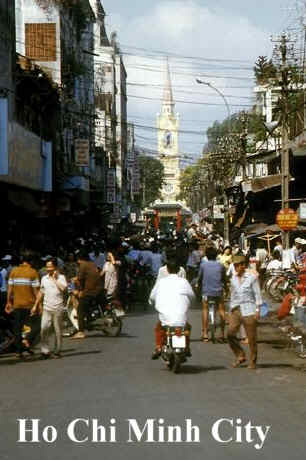
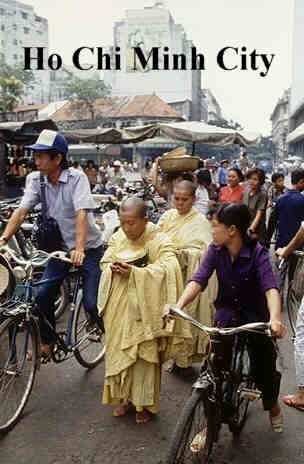
Busy Streets of Ho Chi Minh City
Bicyclists and pedestrians crowd the
streets of the Cholon section of Ho Chi Minh City, the largest metropolitan area
in the Socialist Republic of Vietnam. Formerly known as Saigon, the city has
undergone tumultuous change since its founding in the 17th century. It was
captured by the French in 1861, occupied by the Japanese in 1940, seized again
by French troops after World War II, and taken over by Communist North
Vietnamese troops in 1975.
Appealing for Alms in Ho Chi Minh City
Buddhist nuns beg for alms in the crowded market streets of Ho Chi Minh City, formerly called Saigon. The city became the chief port of French Cochin China and later the capital of South Vietnam when the country was divided in 1954. Ho Chi Minh City was divested of its political status in 1976, after United States troops withdrew from Vietnam and the country was reunified, with Hanoi as the capital.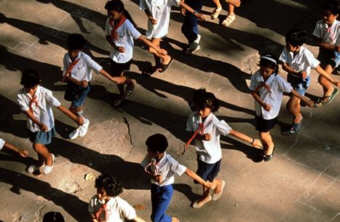
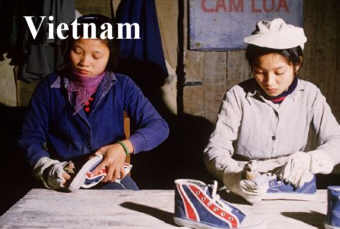
Students in Ho Chi Minh City
In 1979 the Vietnamese government introduced reforms aimed at making education more relevant to the nation’s business requirements. Emphasis was on practical applications, vocations, and ethics. But schools are still underfunded, teachers’ pay is low, and the role of education in economic development is still evolving. Shown here are students going through a drill in Ho Chi Minh City, formerly Saigon.
Vietnamese Women Making Footwear
Vietnam, a Communist-controlled country, encouraged some free-market reforms in the late 1980s to stimulate growth. These reforms, known as doi moi (economic renewal), allowed some farmers and entrepreneurs to engage in smaller-scale private enterprise. Despite the changes, Vietnam remains predominantly a centrally planned economy largely dependent on agriculture. About one-fourth of Vietnam’s total land area is cultivated, and approximately three-fifths of the country’s workforce is involved in farming. Mining and manufacturing makes up about another fifth of the economy.Thailand ![]()
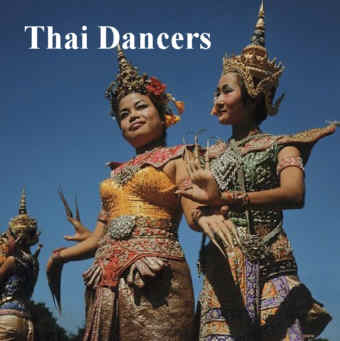
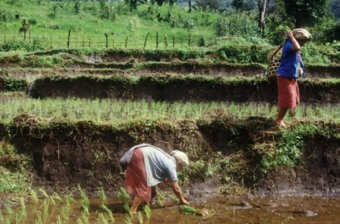
Classic Grace
Elegant
dancers wearing highly stylized and intricately embroidered costumes perform a
traditional Thai dance based on scenes from the Hindu epic Ramayana.
Rice Paddy in Thailand
Thai workers place rice seedlings in the mud beneath the cloudy waters of a paddy (padi). Rice is the staple food throughout Southeast Asia, and Thailand annually produces about 20 million metric tons of the grain, making it one of the country’s major exports. One-sixth of the countryside lies under flooded rice fields, most of which are located on Thailand’s central plain in the valley of the Chao Phraya River .

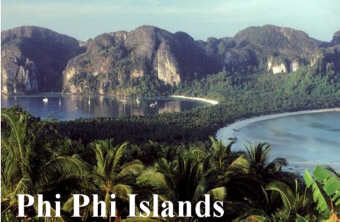
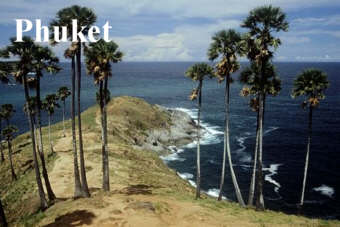
Thailand’s Ko Phi Phi Le Islands
Clear water, beautiful beaches, and scenic mountains draw an international mix of tourists to the Ko Phi Phi Le islands, which are located off Thailand’s west coast in the Andaman Sea southeast of Ko Phuket. The main island, Ko Phi Phi Don, has been extensively developed, and overcrowding during the busiest seasons may be threatening its fragile beach and rain forest ecosystems.
Thailand’s Ko Phuket
Laem Phrom Thep is at the tip of Ko Phuket, which is situated west of Thailand’s Malay Peninsula. The country’s largest island, Ko Phuket lies in Thailand’s narrow southern region that is sandwiched between the Andaman Sea to the west and the Gulf of Thailand to the east. The island is an international tourist destination and home to many beaches, hotels, national parks, wildlife, and water sports. Local residents generally work in the tourism industry or in agriculture and pearl farming. Odyssey Riders and Staff
Odyssey Riders and Staff
